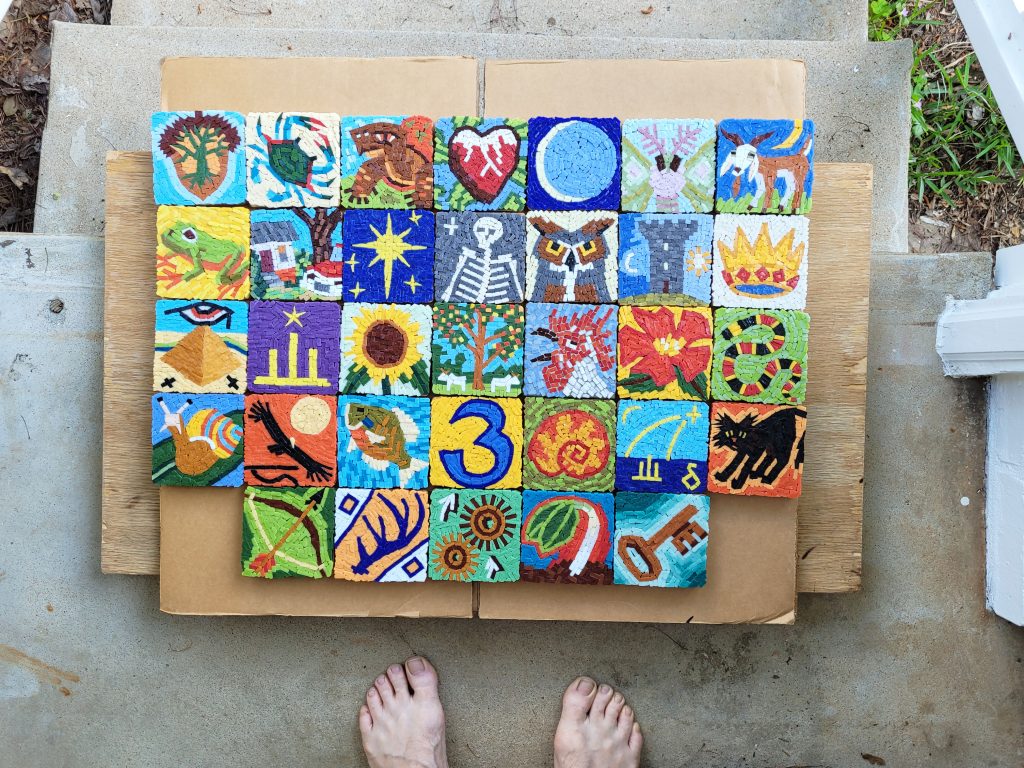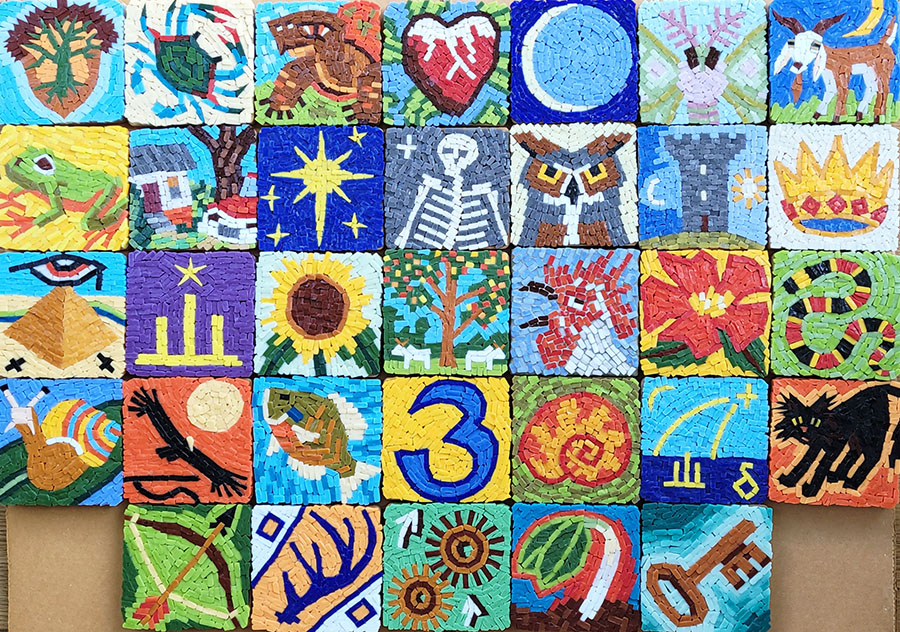I have been making some small mosaics on our bamboo mosaic coaster backers, and I wanted to share a photo of the collection so far and talk about some more advantages of working in a series of smalls.
Each of these coasters will be a “tile” that is used in a large sculpture that is in the form of a framed altarpiece with a small door at the center. An altarpiece is a backdrop for an altar or sacred relic. The wall in which the door is set is tiled with these coasters and makes up most of the area of the flat altarpiece.
I’m thinking I will use the sculpture as a removable cover for my generically-tiled fireplace. Then I could make a little art shrine in front of that, nothing elaborate, mostly found-object curios for my cats to knock over.
The whole assembly will be called the Doorway of Curiosity. It will be fun to hear what little kids ask about it. I’ll put the dinosaur bones and gold ore in front of it.
Anyway…
Back to the advantages of a series of smalls.
Many Are Called
“Many are called, but few are chosen.”
Not all of these mosaics will make the cut and end up on my sculpture, and that is a very good thing.
Being able to take a risk and try something different without being committed to using the results is very liberating.
I will use most of these coasters as tiles for my sculpture, the vast majority in fact, but I can tell right now that the cat mosaic won’t be used. It doesn’t have the right mood. The cat looks sad and scared. That’s not the right feel for a doorway of curiosity.
If you design a larger project built from small studies, you put yourself in the position of being able to use only the best of what you make for the actual project.
Art Versus Real Life
My mind never designs just one version of anything. My mind spends a lot of time detailing alternative versions even though they won’t be the version I actually make.
I think this problem is shared by a lot of visual artists and creative makers.
Small works help me with that overwhelming feeling of having more ideas than time. For me, that feeling can strike pretty hard if I am working on a larger project that keeps getting interrupted by real life.
We all have periods when life stuff gets out of hand and studio time is limited.
How do you keep working on your art during the busier periods in your life?
The beauty of working in a series of smalls is that they can be completed in shorter studio sessions, sessions that might be frustratingly inadequate for a larger work.
Over the past twelve months, I rewired my house and worked on a ton of ecology projects and did a lot of maintenance that I had put off over the pandemic.
Choosing this series of small mosaics as the art project for this busy period was the right thing for me.
When I was younger, I noticed that busy periods resulted in more frustration with my art because I would suddenly find myself binging on a project that had exploded out of my mind.
Those passion projects that explode out of nowhere like that usually aren’t small or practical. It’s better to conceive of projects that can accommodate time limitations, and a series of smalls does that.

Photographing Your Artwork
It’s fairly easy to make catalog-worthy photos of your artwork, even with a smartphone, which is how I made these photos (Samsung Galaxy 8).
Take at least one photo with the camera pointed directly at the artwork. Don’t photograph two-dimensional artwork from an angle so that it is foreshortened in some way.
Don’t photograph your artwork indoors under yellow artificial light.
Here’s how you do it.
- Photograph your artwork outside, but not in direct or saturated sunlight. Late afternoons and overcast days are good.
- Lay your artwork flat on the ground and photograph it straight down. Use a stepladder if needed.
- Make sure that there is a straight gap of background showing all the way around the artwork. If the gaps run at an angle to the edge of the artwork, then the camera isn’t being held perfectly perpendicular to the artwork.


Leave a Reply